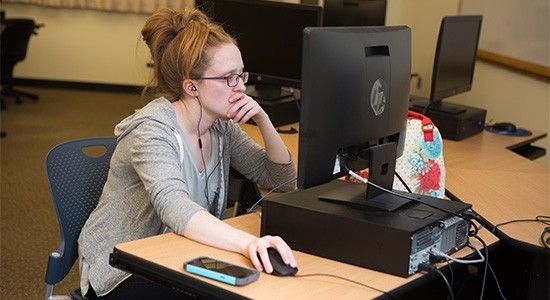Course Placement Information
Before registering for first semester classes, new and transfer students meet with an advisor to discuss their course placement. When reviewing your records to prepare for your advising session, our advisors review your high school and/or college transcripts, information provided you on your Advising Form, and the student’s degree program and required courses.
Tompkins Cortland Community College tries to minimize the use of placement tests. We use multiple measures to place most students in their first semester courses by looking at criteria such as:
- High school GPA (for students who graduated in the past ten years)
- Regents exam scores (for New York high school graduates )
- Other standardized test scores (like the SAT, ACT, TASC, or GED)
- English Background Survey (login with your TC3 email: username@mymail.tc3.edu)
- Math Background Survey (login with your TC3 email: username@mymail.tc3.edu)
- Student provided information from your advising session
Based on this holistic assessment, some students may be required to complete support courses. All support (non-credit) courses are taken in the same semester as a support course for your college level course. As an example if you need support in developing your writing skills, you may take ENGL100 your first semester with ENGL098 (the support course). Math courses also have support courses to help students build their math skills.
Students who have college credit in English or Math are placed according to their transcript evaluation. Grades of C or better in college credit bearing English composition or math courses are required for credits to transfer to Tompkins Cortland.
Some students may need to take a placement test. This includes:
- Speakers for whom English is not their native language (ESL: English as a Second Language students)
- Students seeking to place into a higher level course in English or math
- Students seeking to meet the Ability to Benefit standards for college admission
If you have questions about whether or not you need to take a placement test, please email success@tompkinscortland.edu.
If testing is required, students' test scores help determine which courses they may take in their first semester. It is best to prepare for these tests ahead of time.

What to know about Placement Tests:
- Students who need to test will take a test called ACCUPLACER on a computer.
- Bring a photo ID to the test. Government issued photo ID is best (e.g. driver's license, learner's permit, state issued photo ID card, or passport). If you only have a high school photo ID, you must also bring a copy of your birth certificate.
- Only basic keyboard and/or mouse skills are necessary.
- Most questions are multiple-choice.
- The multiple-choice sections of the tests are not timed.
- Students may use scrap paper and a pencil for math calculations. Calculators, phones, or translators are not permitted on the test. Some questions provide a calculator within the ACCUPLACER system that may be used.
- Remote proctoring is available.
Students with Disabilities should contact Access & Equity Services in the Baker Center for Learning to arrange accommodations for placement testing. Test accommodations must be arranged BEFORE the test date. Accommodations may include, but are not limited to, screen magnification, taped administration, screen reader, writing accommodations, or use of a calculator. Documentation may be required to provide test accommodations.
Where to find preparation materials for the placement test:
There are numerous websites that contain practice tests and information to help "brush up" on your skills.
ACCUPLACER Next-Generation Tests
Use this site to obtain basic descriptions and sample questions for all the ACCUPLACER Next-Generation tests. Student can also download a free study app.
Go2Guide
This guide provides an overview of the content of MATH120 (College Algebra) and MATH200 (Statistics). You can also learn about our math BOOST program, a non-credit program students complete before the semester begins to refresh their math skills. There are additional "self-assessments" in this guide which students can take to practice. Paper and pencil math tests are available to place up into the next level of math. Students must contact Danielle Bethoney, chair of the Math Department, to request to take these tests. Students should review the Go2Guide content, which includes chapter by chapter outlines and videos which demonstrate each mathematical concept prior to trying to test into a higher level math course.